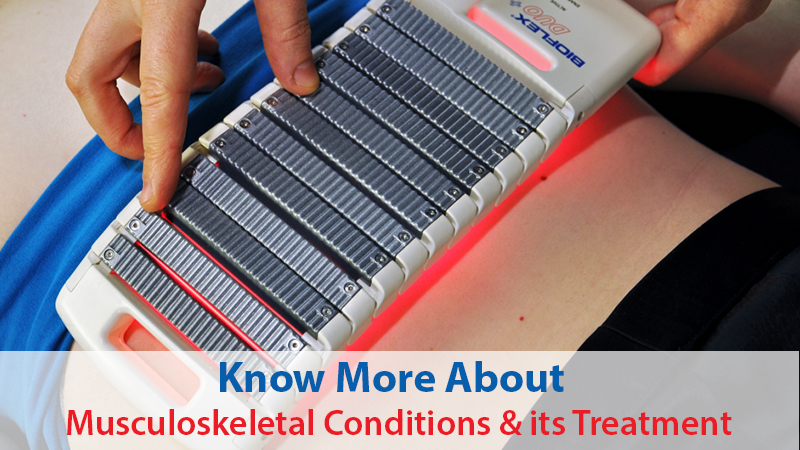
Musculoskeletal pain affects the individual’s joints, muscles, ligaments, tendons, nerves, blood vessels, discs, or bones. The pain results in an injury to the body movement system of an individual.
The musculoskeletal conditions include carpal tunnel syndrome, tendonitis, rheumatoid arthritis, osteoarthritis, bone fractures, fibromyalgia, degenerative disc disease, herniated disc, and others. These conditions are common at all ages and everyone is at a risk to suffer from such conditions.
The severity of these conditions varies in terms of signs and symptoms. In most cases, it results in discomfort and pain, affecting the everyday activities which mostly recovers with proper diagnosis and treatment. So, before having a look at how musculoskeletal conditions are more commonly seen, let’s have a look at the symptoms and causes:
The common areas affected by musculoskeletal pain disorders (MSD) include shoulders, neck, wrists, legs, back, hips, knees, or feet. These symptoms affect everyday activities which include commuting, walking, typing, or others. It results in a restricted range of motion with trouble faced in completing the daily tasks.
The symptoms of musculoskeletal conditions vary from one person to another suffering from MSD.
The most common symptoms include:
The commonly seen causes of musculoskeletal conditions mainly depend on our daily activities.
These stressful activities with the same posture result in a wear and tear effect over the joint. Different types of trauma like jerking movements, auto accidents, fractures, falls, and sprains, direct blows to the area, or dislocations can also cause impairment of the musculoskeletal system.
The work-related causes include long-term immobilization, prolonged awkward working posture, repetitive movements or overuse of specific joints can also result in adverse effects on the musculoskeletal system.
With the progress of musculoskeletal disorders, you start losing strength and productivity. This leads to chronic musculoskeletal pain.
The impairment of the musculoskeletal system leads to depletion of physical activities, impairment of mental health, and enhanced healthcare costs.
According to the burden of disease profiles during 2016 a massive increase was seen in non-communicable disease i.e. MSD of around 61.4% when compared to the data during the 1990s i.e. around 43.9%. Another example of a rise in osteoarthritis was seen from 1990 to 2016 i.e. around 104% while spinal pain also being the leading cause of locomotor system disability since 1990.
This transition of health profiles shows why it is important that we should focus more on health care, especially the preventive, promotive, and rehabilitative types of healthcare.
The focus on primary healthcare services will have a positive impact on the global population which will improve the functioning ability of an individual especially during old age.
Musculoskeletal disorders are more common than we think and it affects every individual at some point in their life. One out of three individuals is affected by musculoskeletal disorders apart from their age. Most of them have to spend the rest of their lives with painful and chronic musculoskeletal conditions due to improper diagnosis and treatment strategies.
Let’s look at some of the illnesses that are related to our musculoskeletal system. This will help us understand how common is musculoskeletal pain.
Arthritis affects muscles, bones, and/or joints. So, arthritis is definitely a musculoskeletal disorder that progresses with time, if untreated.
Sciatic pain involves the intervertebral discs of the spine (a part of your skeleton). So, yes it’s also a type of musculoskeletal disorder in which the sciatic nerve is compressed due to several reasons including disc slip.
There are various mobilization therapies for treating musculoskeletal conditions. The medicines utilized for treating MSD include NSAIDS, Ramelteon, Zolpidem, and others.
Different treatment options include anti-inflammatory or anesthetic injections, stretching or muscle strengthening exercises, occupational or physical therapy, acupuncture, biofeedback technique, therapeutic massage, chiropractic care, and others.
The latest therapy used for treating MSD includes laser therapy which results in photobiomodulation causing the release of photons within the deeper layers of tissue.
BioFlex Pakistan is a well-reputed musculoskeletal clinic, delivering highly effective treatments for many conditions, as they enhance the repair of the connective tissues, regeneration of cells, enhance the functioning of nerves surrounding tissues, and many other reparative features.
This non-invasive procedure is highly efficient for treating musculoskeletal pains and disorders, and enhances the recovery period.
Read this case study by BioFlex Pakistan to see how we treat common musculoskeletal disorders such as Achilles tendonitis.
When a person is exposed to the risk factors of MSD, he starts feeling musculoskeletal pain. When the body is incapable of recovering, the musculoskeletal system results in an imbalance. When this imbalance keeps on persisting it leads to the development of musculoskeletal disorders.
Once these musculoskeletal conditions are immediately diagnosed, they can be easily treated with laser therapy. Once you attend multiple sessions of laser therapy you can start recovering, and ultimately you can relieve yourself of your chronic musculoskeletal pains.
Share
Book Your Appointment
